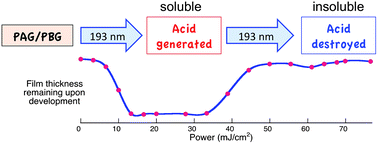Single component photoacid/photobase generators: potential applications in double patterning photolithography†
Abstract
193 nm light as an excitation source for resist patterning is limited due to the inability to achieve pitch division much below limits of λ/2. Current techniques are examining the use of a variety of photochemical manipulations as a means to extend lithographic patterning to small, more defined images. Double patterning, or dual tone lithography, has recently garnered considerable interest due to the potential of patterning two features within one excitation exposure. In this contribution, single component carbamate photoacid/photobase (PAG/PBG) generators are studied as potential substrates for implementing dual tone lithography. At lower exposure powers, only the acid is generated and complete film dissolution was observed, while at higher 193 nm laser powers, photobase activation resulted in little to no film dissolution. Ideally, at intermediate laser doses, both the photoacid and photobase are activated giving rise to the desired double patterning. The energy required to initiate dual tone characteristics was found to be easily adjusted using the additional of amine quenchers or via manipulation of the PAG/PBG concentration. Film thickness measurements were used to determine the energies required for both photoacid and photobase activation, while laser flash photolysis and NMR spectroscopy studies were used in an attempt to understand the PAG/PBG activation mechanism.


 Please wait while we load your content...
Please wait while we load your content...